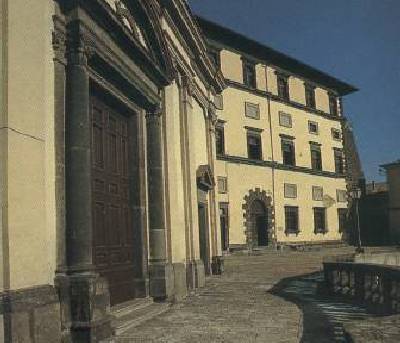| Gradoli
is a pleasant little town of Upper Lazio, situated north
of Lake Bolsena. It has an altitude of 460 metres; its
territory is 3,750 hectares with a beach of 8 kilometres.
On its hills grow excellent vineyards producing Gradoli's
D.O.C quality Aleatico and Grechetto. Other noted products
are the famous grappa and extra virgin olive oil. In
Gradoli you can also taste the exquisite lake fish and
other local specialities. This town's origins can be
traced back to the Middle Ages. In the 13th century it was
annexed by Orvieto and later on, in 1537, by the Dukedom
of Castro, then it fell into the hands of the Church in
1646. A monumental palace was built in 1515 during the
dominion of the Farnese Family. It had been commissioned
by Cardinal Alessandro Farnese (the future Pope Paul III)
to architect Antonio da Sangallo the younger as a wedding
gift for Pierluigi Farnese and Girolama Orsini di
Pitigliano. Visitors are allowed in the wide rooms of the
palace to view the vivid a grottesche decorations, the
monochrome friezes, optical illusion images and a recently
restored coffered ceilings adorned with beautiful
paintings. The Museum and the Centro di Documentazione del
Costume Farnesiano is housed in this palace and located on
an entire floor. Here, numerous reproductions of noble and
popular garments from the 15th, 16th,
17th centuries are shown and also illustrated
through multimedia facilities. |
 |
Near
Palazzo Farnese is The Chiesa Collegiata di Santa
Maria Maddalena. This church is dedicated to the
patron saint and it was erected in the 17th
century. After a severe blaze it was completely
restored according to its original Baroque style. It
contains a very fine walnut pulpit by Matteo Siler
who started the work, but left it unfinished. The
precious frescoes of the apses and the incredible 15th
century christening font by Isaia da Pisa is also an
absolute must. From the church the visitor can have
access to the museum delle Arti Sacre exhibiting a
group of Renaissance frescos of Mannerist style,
liturgy paraments, candelabra, sacred furnishings
and ex-voto.
The feast of the village, dedicated to Santa Maria
Maddalena takes place on 22 July, but the
celebrations actually begin a few days earlier, with
dance, fireworks and an open-air cinema programme.
Near the lake, within 7 km of Gradoli, there is the
15th century church of San Magno which
was bestowed the "forgiveness of San
Magno", namely the plenary indulgence for all
those who visit the church during the first Vespri
masses, at sunset, on 19 August. This special
privilege was granted in 1611 and then confirmed by
Pope Benedict XIV in 1754. |
|
On
this occasion a special feast is celebrated with a solemn
procession, music, panini and wine at will. It is two
centuries now that the members of the "Purgatory
Brotherhood" walk through the streets of the village
on this occasion, wearing their traditional habits and
begging for alms. They collect money, food and all sorts
of things that can be put for auction sale in the village
main square. According to tradition, in order to support
the Purgatory souls on Ash Wednesday, the Brotherhood's
members prepare a banquet for which the local winery
offers hospitality to about 1600 people. The menu is based
on tench soup, fried or stewed cod, delicious homemade
cakes, and all is washed down with the local Grechetto and
Aleatico.
Aleatico in festa is an event, which takes place at the
last weekend of August when local products, such as DOC
Aleatico wine, cakes and other gastronomic specialities
are offered for tasting.
Le Tentavecchie is a legendary, old festivity taking place
over three days before Epiphany (6 January). People take
to the streets, making a big racket to... "Scare away
the witches". |

